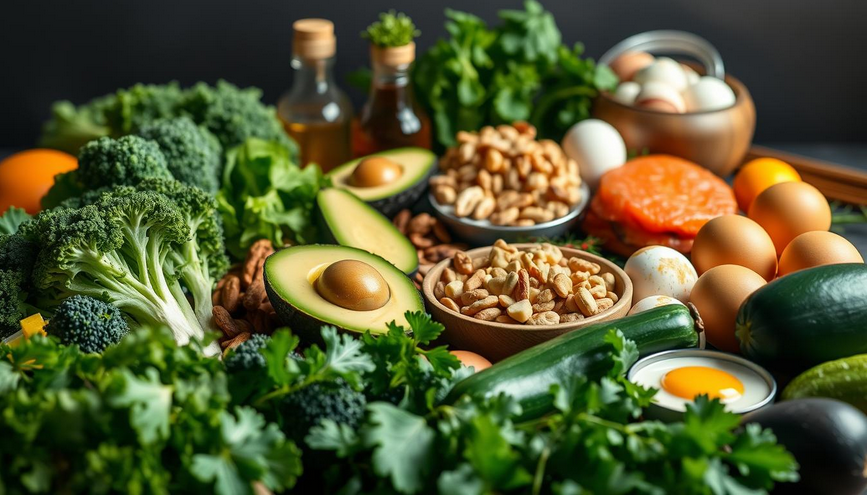Imagine turning your body into a fat-burning machine. You could lose weight and feel healthier. The keto diet is a low-carb, high-fat diet that does just that. It’s been shown to help with weight loss and lower disease risk.
In 2020, the keto diet was the most searched diet in the U.S., with 25.4 million searches1. It’s becoming popular for a healthier lifestyle. Knowing what the keto diet is and how it works is key to making good diet choices.

Introduction to the Keto Lifestyle
The keto diet has 70-80% fat, 5-10% carbs, and 10-20% protein. This is different from the usual American diet. The keto diet is valued at $9.57 billion globally in 2019.
It requires 60% fat, 30-35% protein, and 5-10% carbs. This can be hard to follow. But, the benefits make it worth trying.
Key Takeaways
- The keto diet is a low-carb, high-fat diet that can help with weight loss and improve overall health.
- The ketogenic diet was the most Googled diet in the United States in 2020, with 25.4 million unique searches.
- The keto diet typically consists of 70-80% fat, 5-10% carbohydrates, and 10-20% protein of total daily calories.
- The global ketogenic diet market was valued at $9.57 billion in 2019.
- The keto diet requires a macronutrient composition of 60% fat, 30-35% protein, and 5-10% carbohydrates.
- The keto diet can help lower the risk of certain diseases, such as heart disease and type 2 diabetes.
What is the Keto Diet: Understanding the Basics
The ketogenic diet is a diet low in carbs and high in fat. It helps with weight loss and better blood sugar control. It makes the body burn fat for energy, which is good for mental clarity and energy.
Ketosis is when the body makes ketones from fat. This started in the 1920s to help with epilepsy. Now, it’s used for weight loss and better sports performance, backed by research.
To follow the keto diet, eat less than 50 grams of carbs a day. Eat more fat and some protein. Foods like meats, fish, eggs, and full-fat dairy are good. Also, healthy oils and fats are key.
How Your Body Transforms on the Ketogenic Diet
When starting a keto diet, your body changes a lot. It starts burning fat instead of carbs for energy. This change can take time and might make you feel tired, have headaches, or feel sick to your stomach. But, once your body gets used to it, you’ll see big health improvements.
The keto diet helps control blood sugar, boosts energy, and aids in weight loss. It’s not just for losing weight. It’s about making your whole body healthier. By eating less carbs and more fat, your body makes ketones. These ketones are a new energy source.
Here are some key benefits of the keto diet:
- Improved blood sugar control
- Increased energy levels
- Weight loss
- Improved mental clarity and focus
Remember, the keto diet isn’t for everyone. Always talk to a doctor beforestarting a keto diet.

Essential Benefits of Following a Keto Lifestyle
The keto diet helps with weight loss and better blood sugar control. It works by cutting down carbs and eating more fat. This makes the body use fat for energy, helping you lose weight. A good keto diet plan can help you reach your weight loss goals and improve your health.
Key benefits of the keto diet include weight loss, improved mental clarity and focus, and increased energy levels. It also helps control blood sugar and makes insulin work better. Plus, it can lower blood pressure and triglycerides.
Here are some of the keto diet’s health benefits:
- Weight loss and fat burning
- Improved mental clarity and focus
- Increased energy levels
- Improved blood sugar control
- Reduced diastolic blood pressure and triglyceride levels
The keto diet can greatly improve your health and well-being. It can be customized to fit your needs and likes with the right recipes.
Foods to Embrace and Avoid on the Keto Diet
When you’re on the keto diet, knowing what to eat and what to skip is key. You should eat meat, fish, eggs, and healthy oils. But, avoid foods high in carbs like sugary treats, grains, and starchy veggies.
Good keto foods include non-starchy veggies, nuts, and seeds. Make sure nonstarchy veggies have less than 8 grams of carbs per cup. Nuts and seeds like almonds and chia seeds are okay in small amounts.
Avoid foods high in carbs like sugary foods, grains, and starchy veggies on the keto diet. These foods can make insulin levels go up fast. This stops fat burning and makes you store fat. Stick to whole, nutrient-rich foods that are low in carbs but high in healthy fats and protein.

- Meat: beef, pork, lamb, and game meats
- Fish: salmon, tuna, and mackerel
- Eggs: pastured and organic eggs
- Healthy oils: olive oil, coconut oil, and avocado oil
- Non-starchy vegetables: leafy greens, broccoli, and cauliflower
- Nuts and seeds: almonds, Brazil nuts, and chia seeds
Always pick whole, nutrient-rich foods. Avoid processed and high-carb foods for the best keto diet results.
Common Challenges and How to Overcome Them
Starting a keto diet can be tough. You might feel tired, have headaches, or feel sick to your stomach. Drinking water, eating more salt, and sleeping well can help. Remember, it takes time for your body to get used to it.
Some people get constipated or have diarrhea because of the diet’s high fat and low fiber. Eating foods rich in nutrients and drinking plenty of water is key. It’s also important to check your cholesterol levels with a doctor.
Seeing a doctor before starting the diet is a good idea, if you have health issues. Slowly cutting down on carbs can also help avoid the “keto flu”. Knowing these challenges and how to deal with them can help you stick to the keto diet and reach your health goals.
Social and lifestyle challenges can also pop up, like when you’re out or traveling. Planning your meals ahead can help you stay on track. By staying focused and making smart choices, you can beat these challenges and live a healthier life.
Creating Your Personal Keto Meal Plan
When making a keto meal plan, plan ahead and have keto-friendly foods ready. A good keto meal plan helps with weight loss and clearer thinking. Think about what you like to eat and find keto recipes that fit your taste.
A keto meal plan has mostly fats, some protein, and a little carbs. Drink plenty of water and get enough electrolytes like sodium and potassium. Use a meal planning app or talk to a nutritionist to make a plan that fits your life.
Some great keto recipes include scrambled eggs with spinach and avocado for breakfast. For lunch and dinner, try grilled meats and veggies. Snacks can be nuts, seeds, and cheese. Keep some frozen veggies and ready meals for when you need them.
Here are some tips for your keto meal plan:
- Plan meals for 3-4 days to keep food fresh
- Choose a variety of keto foods, like healthy fats and veggies
- Drink lots of water and get enough electrolytes
- Be ready to change your plan and have backup meals
Conclusion: Starting Your Keto Journey
Starting your keto journey is more than just a diet. It’s a lifestyle change that can greatly improve your health and happiness. By following the keto diet’s rules, you can enter a state of ketosis. This means your body uses fat for energy instead of carbs.
It might take time for your body to get used to this new way of working. Don’t worry about feeling tired or craving sugar at first. These feelings are normal and will go away as you get used to it. Soon, you’ll feel more energetic, clear-minded, and might even lose weight.
It’s important to listen to your body and make changes if you need to. The keto diet works differently for everyone. By paying attention to how you feel and making smart choices, you can make keto work for you.
See your keto journey as a chance to grow and learn about yourself. With the right attitude and dedication, the keto diet can change your life for the better.
FAQ
What is the Keto Diet?
The Keto Diet is a diet low in carbs and high in fat. It helps your body enter a state called ketosis. This state is when your body burns fat for energy instead of carbs.
How does the Keto Diet work?
The Keto Diet works by cutting down carbs to less than 50 grams a day. You eat more fat instead. This makes your body use fat for energy, not carbs.
What are the benefits of the Keto Diet?
The Keto Diet can help you lose weight and control blood sugar. It also boosts energy and mental focus. Your brain uses ketones for energy, making you feel sharper.
What foods are allowed on the Keto Diet?
You can eat meat, fish, eggs, and healthy oils on the Keto Diet. But, avoid sugary foods, grains, and starchy veggies. They have too many carbs.
What are the challenges of the Keto Diet?
Starting the Keto Diet can be tough. You might feel the “keto flu” as your body adjusts. But, drinking water, eating more salt, and sleeping well can help.
How do I create a Keto Meal Plan?
Making a Keto Meal Plan can be hard, but there are many resources to help. Plan your meals in advance. Include foods like scrambled eggs, avocado, and spinach for breakfast. For lunch and dinner, try grilled meats, fish, and veggies.

